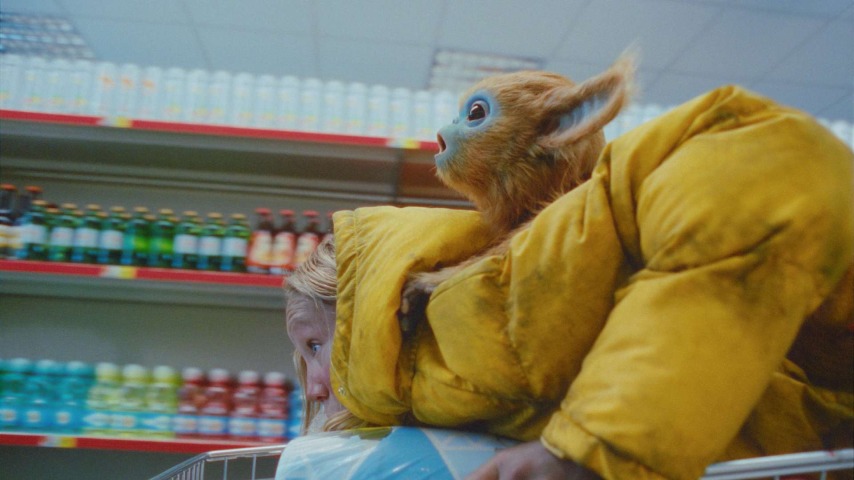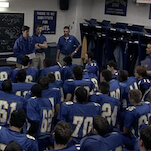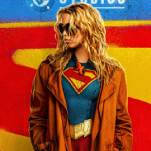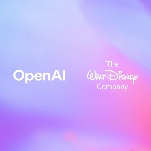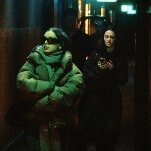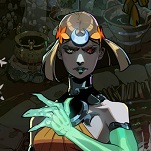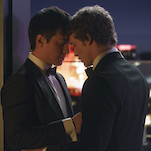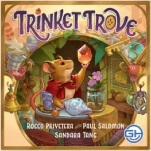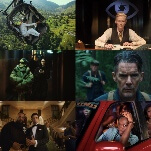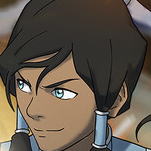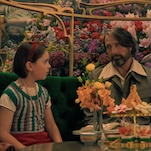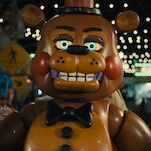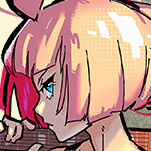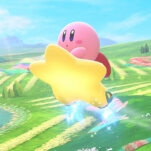In Steven Spielberg’s E.T. The Extra Terrestrial, a big-eyed alien critter is stranded on Earth. After meeting Elliott (Henry Thomas), E.T. is protected by a band of local kids determined to keep him out of the clutches of the feds. When it’s time to say tearful goodbyes, Elliott asks his fantastical friend to stay. Of course he’ll stay, E.T. tells him, pointing at the boy’s forehead with a glowing finger, right there. And stay he did. E.T. has lingered in the minds of filmmakers since its smash-hit summer in 1982, and has become the cornerstone in the fantasy coming-of-age genre—or, at least, the section focusing on the relationship between a young outsider and their clandestine friendship with a creature or alien. Now, A24 wants to cash in on the dazzling effects, rough-and-ready characters, and sharp emotional power of Amblin’s cornerstone film (E.T. is in their logo). While it’s reductive to suggest that The Legend Of Ochi is indebted to any single ’80s film, writer-director Isaiah Saxon’s folkish fantasy set on a remote, mystical Black Sea island struggles to imagine outside the rigid parameters of Spielberg’s 40-year-old family picture.
In Saxon’s defense, it’s not like the fantasy coming-of-age movies between E.T. and Ochi have shown a wealth of ingenuity. Elements of The Iron Giant, the How To Train Your Dragon films, Lilo & Stitch, Super 8, Stranger Things, and David Lowery’s Pete’s Dragon have all incrementally paved the way for the lackluster Ochi, which skates by on highlighted extracts from the canon of “young protagonist forging an unlikely but binding friendship with a strange, unwanted creature” cinema. In Ochi‘s efforts to outdo its commercial, big-budget competitors that have more intimate, mature drama, it becomes a case study in how valorizing the formulas of beloved films can sour a whole subgenre.
Its protagonist is Yuri (Helena Zengel), whose father Maxim (Willem Dafoe) is a braggart with a makeshift army of local boys, intent on wiping out the indigenous species of monkey-like Ochi with his newly indoctrinated adolescent minions. Yuri has spent her whole life feeling like Maxim is trying to make her into someone she’s not, then listens to her heart when she discovers a lost baby Ochi and escapes into the wild to return the critter home. But what damns the lack of emotional finesse in The Legend Of Ochi is that, while aiming for a family audience, it’s also interested in courting an older crowd with a higher degree of emotional sensitivity—viewers hopefully drawn to the A24 brand, and ones far more likely to be won over by Saxon’s intertextual aesthetic goals than children.
But the films that can genuinely appeal to both groups—movies like Pan’s Labyrinth or Okja—often incorporate mature politics and real history into their fairy-tale and adventure stories. These examples work because there’s a tension between the child’s perspective and the grimmer reality of their environment, which gives an adult audience a deeper understanding around why the broad emotions of children’s fantasy movies have such an impact. Living in a fairy-tale kingdom or having a big, lovable creature as a best friend are unrealistic retreats into fantasy, but at least one can understand why they have such an acute, heightened appeal.
The Legend Of Ochi, by contrast, wants an older audience but none of their maturity. The fingerprints of Jim Henson’s dark fantasy are all over the aesthetic—the puppetry, animatronics, and set design—but where Labyrinth felt like a dream extending from a clearly defined, teasing, and subconscious teenage anxiety, Yuri is stuck reacting to her father’s verbose and essentialist worldview, which prioritizes a certain type of loyal masculinity. Dafoe plays his boorish part with a constant note of irony, making him feel like the only significant character in the room. As a consequence, Yuri’s characterization is pushed to the margins, a stereotype that flits between stillness and wildness in lieu of a meaningful emotional conduit for the story. Yuri is simply what the family fantasy template requires to access the swells of pathos and awe expected of the genre.
Even though The Legend Of Ochi strives for a more grown-up audience, it refuses the type of tension between reality and fantasy that made Okja and Pan’s Labyrinth richer texts. The story instead leans hard into the established formula for kid-and-creature adventures: The fantastical being is considered a rogue element overstepping into ordered society, and because the powerful older generation ostracizes this fantasy creature, the young heroes must keep it secret, ultimately proving their abilities against the odds. But by trying to embody a more sensitive and intimate version of the adventure-driven family fantasy (as compared to the tentpole studio projects), Ochi sands down the contributions that smarter commercial films have made to the template, to its own detriment.
The concept of found family is crucial to fantasy coming-of-age films: Hiccup and Toothless, Lilo and Stitch, Elliott and E.T. are positioned as more than family because their traditional family structures are incomplete, inadequate, or affected by tensions outside their control. Elliott’s mother (Dee Wallace) is trying to raise three rambunctious kids on her own after her husband left. Lilo (Daveigh Chase) lives with her older sister after their parents died in a car crash, with Nani (Tia Carrere) juggling the instability of Kauai’s tourism industry with the threat of social services hanging over them. Hiccup (Jay Baruchel) is considered weak and useless by his Viking clan—and, he fears, by his chieftain father (Gerard Butler).
A family of choice challenges traditional society, dodging its rules and hierarchies to show that everything promised by conservative order can be sourced elsewhere. For kids, what’s a better symbol of an alternative family structure than inviting a cute alien into your loving support circle? The creatures intruding on the characters’ hometowns risk being hurt by society. When the young characters realize this, they quickly empathize with them. They are all outsiders with diminished agency, who don’t know how to better their situation and can’t articulate their pain. Through their connection, the protagonists forge a road through to emotional clarity and inner strength. In the case of Ochi, this connection is literal—exposure to the baby Ochi gives Yuri access to its clicky-whistle language, and their closeness (an echo of E.T.’s psychic link with Elliott) only makes the Ochi’s eventual return to their own kind more bittersweet.
But Ochi treats this found-family heart as a means to an end, directing Yuri back to her mother (Emily Watson) rather than believing in a new structure of relationships. The trope of a fantasy creature permanently returning to its kind, where it belongs, has an unflinching certainty that isn’t just boring, it’s weirdly prescriptive. The baby Ochi belongs with its own people, and by extension, Yuri belongs with her sensitive, compassionate mother who Maxim has unfairly kept at a distance. The family unit is something to be mended rather than transcended; the unique bond between human and creature was always temporary. That Ochi transposes E.T.’s relationships makes its dismissal of personal renewal through found family an unsatisfying final note.
This narrative miscalculation is strange, because even large studio projects have been able to feel fresh within this structure. In The Iron Giant, Hogarth (Eli Marienthal) and the Giant (Vin Diesel) remain the most important people to each other throughout the film: the drama focuses on existential questions of what the Giant can mean to his friend and society rather than trying to answer where the Giant will be accepted without resistance. In Lilo & Stitch, the sisters and alien experiment resist the easy narrative crutch of separating human and creature, demonstrating why ‘ohana can be meaningful. Even though How To Train Your Dragon: The Hidden World closes on Toothless returning to his kind, the bittersweet separation is only so affecting because the series spends three films committing to Hiccup and Toothless growing together.
Ochi attempts to distinguish itself by challenging the hierarchical view of island life held by Yuri’s father with the empathy of her mother, but in trying to access emotional intimacy, the film ignores the character-driven specificity of these aforementioned films. Ochi considers its genre formula as elemental: not something to build a precise and singular story off, but something that inherently holds the emotions the film wants to access. With its smaller-scale slant and handcrafted detail, it may feel like Ochi is a rejection of the loud, obvious ’80s-nostalgia genre projects like Stranger Things or the Ghostbusters legacy sequels, but it makes the same mistakes. It assumes that recycled emotions and story beats hold meaning because they echo films its creators have a strong relationship to. It’s not just that Ochi doesn’t properly deploy its narrative template, but that its filmmakers consider the template as more meaningful than the characters and details that fill it.
This is evident in the scenes between Yuri and the Ochi. These are ostensibly the heart of the film, but they reek of transitional necessity. In order to get to the emotional peaks pre-scheduled in the story, Saxon barely sketches in sequences like a rebellious supermarket sweep or a conversation where they share their respective languages. In the film’s hurry to get to the contemplative close-ups of regretful parents and the sentimental scenes of children articulating their deep, sad desires, Ochi skates through the actual meat of the adventure story without realizing that films like E.T. only made audiences cry because they featured serious danger and tonal variety on the road to their endings. In Ochi, the drama is obligatory, something to fulfill a type rather than tell a tale.
The Legend Of Ochi is not compromised because the coming-of-age fantasy genre is inherently tired, but rather because it exemplifies how empty genre conventions can feel if they aren’t properly interrogated. Everything promising and appealing about Ochi—relationships between outsiders, a world teeming with unique life, journeys of belonging and becoming—is flattened and soured by this blind devotion. In trying to deliver a coming-of-age fantasy movie tailormade for grown-ups, Ochi validates a reductive nostalgia for films of the past. In putting its entire weight behind detail, the film merely gestures at the emotional structure of its influences, and calls it good enough. By definition, a coming-of-age fantasy movie should take someone over personal thresholds within a fantastical spectrum of new ways of living. But like E.T.’s voyage home, Ochi can only lead its audience somewhere familiar. That this is its aim in the first place drains the magic from the very genre it wants to elevate.
